
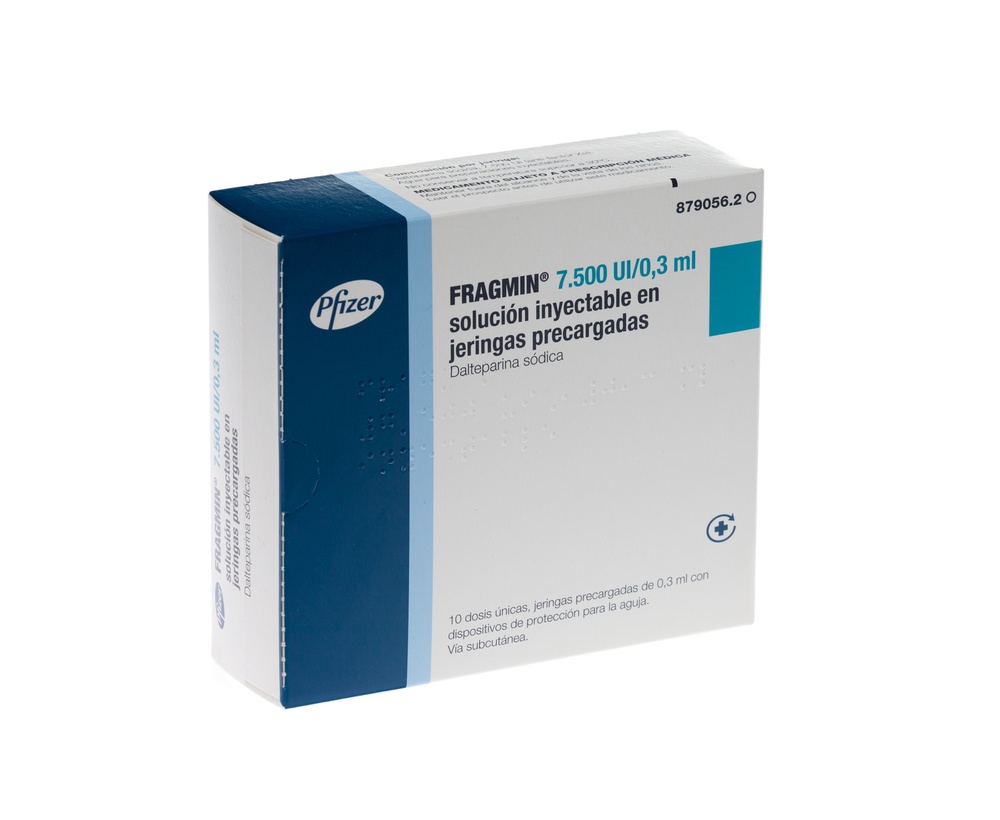
FRAGMIN 7,500 IU/0.3 ml PRE-FILLED SYRINGE SOLUTION FOR INJECTION

Ask a doctor about a prescription for FRAGMIN 7,500 IU/0.3 ml PRE-FILLED SYRINGE SOLUTION FOR INJECTION

How to use FRAGMIN 7,500 IU/0.3 ml PRE-FILLED SYRINGE SOLUTION FOR INJECTION
Introduction
Package Leaflet: Information for the User
FRAGMIN 7,500 IU/0.3 ml solution for injection in pre-filled syringes
dalteparin sodium
Read all of this leaflet carefully before you start using this medicine because it contains important information for you.
- Keep this leaflet, you may need to read it again.
- If you have any further questions, ask your doctor, pharmacist, or nurse.
- This medicine has been prescribed for you only. Do not pass it on to others. It may harm them, even if their signs of illness are the same as yours.
- If you get any side effects, talk to your doctor, pharmacist, or nurse. This includes any possible side effects not listed in this leaflet. See section 4.
Contents of the pack:
- What Fragmin is and what it is used for
- What you need to know before you use Fragmin
- How to use Fragmin
- Possible side effects
- Storing Fragmin
- Contents of the pack and other information
1. What Fragmin is and what it is used for
Fragmin belongs to a group of medicines called low molecular weight heparins.
Fragmin 7,500 IU/0.3 ml is used in adults aged 18 years and over for:
- Treatment of deep vein thrombosis with or without pulmonary embolism (to treat blood clots already present in the deep veins - a type of blood vessel -) and for the treatment of unstable angina and myocardial infarction without Q wave (a type of heart attack).
- Prophylaxis of thromboembolic disease in patients with cancer.
2. What you need to know before you use Fragmin
Do not use Fragmin:
- if you are allergic (hypersensitive) to dalteparin sodium, or any of the other ingredients of this medicine (listed in section 6), or to any other type of heparin (medicines that prevent blood clotting) different from dalteparin sodium or to products derived from pigs
- if you have acute gastroduodenal ulcer, cerebral hemorrhage, or other important bleeding
- if you have severe coagulation disorders
- if you have a disease called acute or subacute septic endocarditis (inflammation of one of the heart membranes due to an infection)
- if you have had an operation on the central nervous system, eyes, or ears, or if you have injuries to these organs or system
- if you have a decrease in the number of platelets (cells present in the blood that intervene in blood clotting) and when a test of aggregation in the presence of dalteparin sodium is performed, the result is positive.
If you are being treated with Fragmin, you will not be able to have an epidural or spinal anesthetic.
Warnings and precautions:
Consult your doctor, pharmacist, or nurse before starting treatment with Fragmin if:
- You are going to receive intramuscular injections of other medicines due to the risk of hematomas.
- You have a decrease in the number of platelets or defects in them. Your doctor may request specific tests to determine the cause of this problem.
- You have severe renal impairment (decreased kidney function) or severe hepatic impairment (decreased liver function).
- You have uncontrolled high blood pressure.
- You have retinal disorders (a part of the eye) due to diabetes or high blood pressure.
- You have recently undergone surgery or have a high risk of bleeding.
- You have had an acute myocardial infarction and are being treated with this medicine.
- You are at risk of elevated potassium levels in the blood due to some disease or taking certain medications. Your doctor may perform tests to measure potassium levels.
- If you are undergoing epidural (in one of the membranes surrounding the brain and spinal cord) or spinal (in the spinal cord) anesthesia, or a lumbar puncture, and you are being given heparin for preventive purposes; very rare hematomas may occur in these areas. If you feel back pain, numbness, weakness in the lower limbs, or any disorder in the functioning of the intestine or bladder, inform your doctor immediately.
- If you have a cardiac valve prosthesis, the preventive doses of Fragmin may not be sufficient to prevent valve thrombosis.
- If you are receiving prolonged treatment for unstable coronary disease, such as prior to revascularization, your doctor may reduce the dose of Fragmin.
- If you are allergic or suspect you have a possible allergy to latex (natural rubber) or if the needle cap of the Fragmin pre-filled syringes is going to be handled by someone with a known or possible allergy to latex (natural rubber). The needle cap of the Fragmin pre-filled syringes is made of latex (natural rubber) which can cause severe allergic reactions in people with a latex allergy.
Considering your condition and/or age, your doctor may perform tests to control anticoagulant activity and avoid the risk of bleeding or recurrence of thrombosis.
Fragmin should not be exchanged with other unfractionated heparins, low molecular weight heparins, or synthetic polysaccharides as their effect may not be the same.
Children and adolescents:
Fragmin is not used in newborns under 1 month of age.
Using Fragmin with other medicines:
Tell your doctor, pharmacist, or nurse if you are using, or have recently used, other medicines, including those obtained without a prescription.
Certain medicines may interact with Fragmin 7,500 IU/0.3 ml; in these cases, it may be convenient to change the dose or interrupt treatment with one of the medicines.
Thrombolytic treatment (which dissolves the clot) or some medicines that affect blood clotting may increase the risk of bleeding when combined with Fragmin:
- Aspirin (acetylsalicylic acid).
- Platelet inhibitors (used to decrease platelet aggregation and reduce the risk of blood clots).
- Thrombolytics (used to dissolve blood clots).
- Non-steroidal anti-inflammatory drugs (NSAIDs) (medicines used to treat inflammation).
- Vitamin K antagonists and other types of anticoagulants.
- Dextran (used in some artificial tears).
Pregnancy and breastfeeding:
Consult your doctor or pharmacist before taking or using any medicine, including Fragmin.
If you are pregnant, you should only use this medicine when clearly necessary, although Fragmin does not cross the placenta.
It is not recommended to use it with epidural anesthesia. Inform your doctor if you have an artificial heart valve.
If you are breastfeeding, inform your doctor; he will assess whether treatment with this medicine is appropriate, as Fragmin passes into breast milk in small amounts.
Driving and using machines:
This medicine does not alter the ability to drive vehicles or use machines.
Fragmin contains sodium
This medicine contains less than 23 mg (1 mmol) of sodium per pre-filled syringe; this is, essentially “sodium-free”.
3. How to use Fragmin
Follow the instructions for administration of Fragmin 7,500 IU/0.3 ml exactly as indicated by your doctor. Consult your doctor, pharmacist, or nurse if you have any doubts.
Remember to take or use your medicine.
Your doctor will indicate the dose, method of use, and duration of your treatment with Fragmin.
Fragmin is administered subcutaneously (by injection under the skin).
If you are going to be administered Fragmin to treat blood clots already present in the deep veins, treatment will start as soon as possible and will continue for at least 5 days or until the levels of prothrombin complex (factors that intervene in blood clotting) return to their adequate level. You may be administered one or two daily doses.
If you are administered in a single daily dose, it will be 200 IU per kg of body weight and per day, and it will be applied by injection under the skin. The daily dose will not exceed 18,000 IU.
If you are administered in two daily doses, they will be 100 IU per kg of body weight and per day.
If necessary, your doctor will perform analytical controls.
If you are administered Fragmin 7,500 IU/0.3 ml for the treatment of unstable angina and myocardial infarction without Q wave, the dose will be 120 IU per kg of body weight twice a day, and it will be applied by injection under the skin. The maximum dose will be 10,000 IU/12 hours, and the duration of treatment will be 6-8 days. Your doctor may consider that you should take low doses of acetylsalicylic acid at the same time.
The injections of Fragmin will normally be administered by a healthcare professional, will be applied under the skin, in the anterior or posterior area of the abdomen, and alternately on the right and left sides.
Use in children and adolescents
Treatment of blood clots in the veins (symptomatic venous thromboembolism [VTE])
The recommended doses depend on the child's body weight and age group. The doctor will perform the calculation. The doctor will advise on the individualized dose of Fragmin according to these criteria. Do not change the dose or treatment schedule without consulting your doctor first.
This medicine is not suitable for use in the pediatric population because the pre-filled syringes do not allow the dose to be adjusted based on the child's body weight. It is recommended to use the 2,500 IU/ml solution for injection in 4 mL vials.
The effect of Fragmin will be controlled after the initial dose and subsequent dose adjustment by a blood test.
How to inject Fragmin
Fragmin is administered by subcutaneous injection (under the skin). This section of the leaflet explains how to administer Fragmin. You should follow these instructions only after being trained by your doctor. If you are not sure what to do, talk to your doctor immediately. You should inject (or administer) the dose of Fragmin at the recommended times by your doctor.
If it is necessary to dilute Fragmin before administration, it should be done by a healthcare professional. You should follow your doctor's instructions on how and when to inject the diluted medicine provided.
Please follow the steps explained below
Step 1: Preparing the syringe for injection will depend on the specific presentation of Fragmin being used.
The Needle-Trapsafety system is specially designed to help prevent needle accidents after correct use of Fragmin. It consists of a plastic safety device attached to the syringe label. It is used to prevent accidental pricks after the correct injection of Fragmin. The needle protection device (Needle-Trap) consists of a plastic tab (clamp) that is aligned in parallel with the needle, firmly attached to the label of the syringe cylinder.
The following actions are required to activate the safety system: Lift the syringe, hold the tip of the plastic needle blocker, and bend it away from the protector (see Figure 1).
Figure 1

Remove the gray rubber cap by pulling it outward (see Figure 2).
Figure 2

You will notice an air bubble in the syringe. This is expected and can be ignored. It is important not to press the plunger yet, as some of the medicine may be lost. The air bubble in the disposable syringes should not be expelled before injection, as this may cause loss of medicine and, therefore, a reduction in the dose.
Now you are ready to administer the injection. Continue with step 2.
Step 2: Choosing and preparing the subcutaneous injection site
Choose one of the recommended injection sites below (see shaded areas in Figure 3):
- A "U"-shaped area around the navel.
- Central area of the thighs.
Figure 3

- Use a different injection site each time a dose is administered.
- Do not administer the injection in areas where the skin is painful, bruised, red, or hard. Avoid areas with scars.
- If you or your child have psoriasis, do not administer the injection directly into any raised, thick, red, or scaly skin plaque ("psoriatic skin lesions").
- Wash and dry your hands.
- Clean the injection site with a new alcohol swab, with circular movements. Let the skin dry completely. Do not touch this area again before administering the injection.
Step 3: Adopting the correct posture
You or your child should be sitting or lying down for the administration of the subcutaneous injection. If you are going to self-inject the medicine, sit in a comfortable position where you can see your abdomen (see Figure 4).
Figure 4
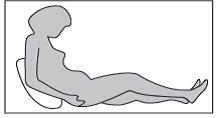
Step 4:
With your thumb and index finger, lift a skin fold with one hand. With the other hand, hold the syringe like a pencil. This will be the injection site.
Step 5:
If you are injecting Fragmin into an adult or yourself,hold the syringe over the skin fold, keeping it at a right angle (i.e., vertically, as in the diagram, and not at an angle). Insert the needle into the skin until it is completely inside (see Figure 5).
Figure 5
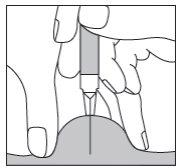
If you are going to inject Fragmin into a child,insert the needle into the skin until the end with a small, quick movement, at an angle of between 45° and 90° (see Figure 6).
Figure 6
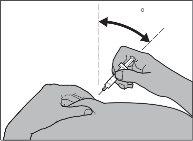
Step 6:
Push the plunger completely down at a slow and constant speed to administer the correct dose. Continue to pinch the skin fold while administering the injection, and then release the skin fold and remove the needle.
If there is any bleeding at the injection site, apply gentle pressure. Do not rub the injection site, as this may cause hematomas.
Press the injection site with a cotton swab for 10 seconds. A slight bleeding may occur. Do not rub the injection site. You can put a bandage over the injection site.
Step 7: If your syringe has a Needle-Trapsafety device, activate it
Place the plastic blocker against a hard, stable surface and with one hand, turn the syringe cylinder upward against the needle, forcing the needle into the blocker until it clicks (see Figure 7).
Continue bending the needle until the syringe exceeds an angle of 45 degrees with the flat surface to permanently disable it (see Figure 8).
(see Figure 7) (see Figure 8)
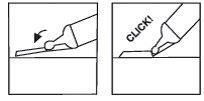
Step 8:
Dispose of the syringe and needle in a puncture-proof container. Keep your puncture-proof container out of the reach of others. When the puncture-proof container is almost full, dispose of it according to the instructions or talk to your doctor or nurse.
If you use more Fragmin than you should
If you have used more Fragmin than you should, consult your doctor or pharmacist immediately, go to the nearest hospital, or contact the Toxicology Information Service, phone 91 562 04 20.
If you forget to use Fragmin
Consult your doctor or pharmacist immediately.
Do not administer a double dose to make up for forgotten doses.
4. Possible Adverse Effects
Like all medicines, Fragmin can cause adverse effects, although not all people suffer from them.
Adverse effects observed frequently (may affect up to one in 10 patients):
- Pain and bruising at the injection site
- Reversible decrease in the number of blood platelets not mediated by immune mechanisms (type 1)
- Bleeding at any point, which has sometimes been fatal
- Temporary increase in liver enzymes
Rare adverse effects (may affect up to one in 1,000 patients):
- Hair loss, skin cell death
Adverse effects of unknown frequency (cannot be estimated from the available data):
- Decrease in the number of blood platelets mediated by immune mechanisms induced by heparin (type 2)
- Severe allergic reactions
- Localized bleeding inside the skull, inside the abdomen, or in other locations, sometimes fatal
- Rash
- Accumulation of blood inside the skull or spinal column (epidural or spinal hematoma)
- Elevation of blood potassium levels
- Osteoporosis (porous bones)
It is expected that the adverse effects in children will be the same as those in adults. However, there is limited information available on the possible adverse effects of prolonged use in children.
Reporting of Adverse Effects:
If you experience any type of adverse effect, consult your doctor or pharmacist, even if it is a possible adverse effect that is not listed in this prospectus. You can also report them directly through the Spanish Pharmacovigilance System for Human Use Medicines: www.notificaram.es. By reporting adverse effects, you can contribute to providing more information on the safety of this medicine.
5. Storage of Fragmin
Keep out of sight and reach of children.
Do not store at a temperature above 30°C.
Do not use Fragmin after the expiration date (CAD) shown on the packaging and outer carton. The expiration date is the last day of the month indicated.
Do not use Fragmin if it contains particles or appears discolored.
Medicines should not be thrown away in drains or trash. Deposit the packaging and medicines you no longer need at the SIGRE Point in the pharmacy. If in doubt, ask your pharmacist how to dispose of the packaging and medicines you no longer need. This will help protect the environment.
6. Package Contents and Additional Information
Composition of Fragmin 7,500 IU/0.3 ml:
The active ingredient of Fragmin 7,500 IU/0.3 ml is sodium dalteparin. Each milliliter of solution contains 25,000 IU (anti-Xa) of sodium dalteparin. The total content per package is 7,500 IU (anti-Xa).
The other components are: sodium hydroxide, hydrochloric acid, and water for injectable preparations.
Appearance of Fragmin 7,500 IU/0.3 ml and Package Contents:
Pre-filled syringes with needle protection device: injectable solution for subcutaneous administration in pre-filled syringes with 7,500 IU (anti-Xa)/0.3 ml in packages containing 10 pre-filled syringes.
Marketing Authorization Holder:
Pfizer, S.L.
Avda. de Europa 20-B. Parque Empresarial La Moraleja.
28108 Alcobendas (Madrid) Spain
Manufacturer:
Pfizer Manufacturing Belgium NV
Rijksweg 12
2870 Puurs-Sint-Amands
Belgium
or
CATALENT FRANCE LIMOGES SAS
Z.I. Nord.
53 Rue de Dion Bouton
87280 Limoges
France
Additional Information for Healthcare Professionals/Users:
Fragmin 7,500 IU/0.3 ml is compatible with isotonic sodium chloride solutions (9 mg/ml) or glucose (50 mg/ml), both in glass vials and plastic containers.
The compatibility of this medicine with other products has not been investigated.
This prospectus was approved in June 2025
Detailed and updated information on this medicine is available on the website of the Spanish Agency for Medicines and Health Products (AEMPS) http://www.aemps.gob.es

How much does FRAGMIN 7,500 IU/0.3 ml PRE-FILLED SYRINGE SOLUTION FOR INJECTION cost in Spain ( 2025)?
The average price of FRAGMIN 7,500 IU/0.3 ml PRE-FILLED SYRINGE SOLUTION FOR INJECTION in December, 2025 is around 55.93 EUR. Prices may vary depending on the region, pharmacy, and whether a prescription is required. Always check with a local pharmacy or online source for the most accurate information.
- Country of registration
- Average pharmacy price55.93 EUR
- Active substance
- Prescription requiredYes
- Manufacturer
- This information is for reference only and does not constitute medical advice. Always consult a licensed doctor before taking any medication. Oladoctor is not responsible for medical decisions based on this content.
- Alternatives to FRAGMIN 7,500 IU/0.3 ml PRE-FILLED SYRINGE SOLUTION FOR INJECTIONDosage form: INJECTABLE, 10,000 IU dalteparin sodium/0.4 mlActive substance: dalteparinManufacturer: Pfizer S.L.Prescription requiredDosage form: INJECTABLE, 10,000 IU/mlActive substance: dalteparinManufacturer: Pfizer S.L.Prescription requiredDosage form: INJECTABLE, 12,500 IU dalteparin sodium/0.5 mlActive substance: dalteparinManufacturer: Pfizer S.L.Prescription required
Alternatives to FRAGMIN 7,500 IU/0.3 ml PRE-FILLED SYRINGE SOLUTION FOR INJECTION in other countries
The best alternatives with the same active ingredient and therapeutic effect.
Alternative to FRAGMIN 7,500 IU/0.3 ml PRE-FILLED SYRINGE SOLUTION FOR INJECTION in Poland
Online doctors for FRAGMIN 7,500 IU/0.3 ml PRE-FILLED SYRINGE SOLUTION FOR INJECTION
Discuss dosage, side effects, interactions, contraindications, and prescription renewal for FRAGMIN 7,500 IU/0.3 ml PRE-FILLED SYRINGE SOLUTION FOR INJECTION – subject to medical assessment and local rules.














